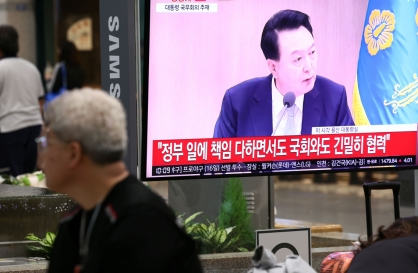[THE INVESTOR] Samsung Electronics is expected to start operating its new semiconductor plant in Pyeongtaek, Gyeonggi Province, earlier than planned to meet the growing demand for 3-D NAND flash memory chips.
According to recent news reports, the Korean tech giant plans to complete the construction of the plant, tentatively called Line 18, in December and start production from the second quarter next year, possibly in April -- about three months in advance.
Demand for 3-D NAND chips is surging as they are widely used in premium smartphones, including the latest Apple iPhone 7 and those of Chinese manufacturers. Samsung, the world’s largest memory chipmaker, aims to further widen the gap with its rivals by beefing up production.
According to recent news reports, the Korean tech giant plans to complete the construction of the plant, tentatively called Line 18, in December and start production from the second quarter next year, possibly in April -- about three months in advance.
Demand for 3-D NAND chips is surging as they are widely used in premium smartphones, including the latest Apple iPhone 7 and those of Chinese manufacturers. Samsung, the world’s largest memory chipmaker, aims to further widen the gap with its rivals by beefing up production.

Electronic Times, a local news outlet, reported on Oct. 4 about 40,000 to 50,000 300-millimeter wafer sheets are expected to be produced during the first phase of the investment worth 3 to 3.5 trillion won (US$2.7-3.2 billion), about one-fourth of the plant’s total production capacity of 200,000 wafers.
The chips are the fourth-generation 64-layer 3-D NAND chips whose production will start first at the company’s plant in Hwaseong, Gyeonggi Province, at the end of this year.
“Samsung had planned to start setting up facilities there from the first quarter of next year,” the newspaper reported citing an unnamed industry source. “But the plan has been advanced as demand for NAND flash memory chips has been soaring since summer this year.”
The new Pyeongtaek complex, consisting of four production lines, will be built on a 2.89 million square-meter site, the largest of its kind globally, within the year. Samsung plans to invest a total of 15.6 trillion won in the facilities in the coming years.
By Lee Ji-yoon (jylee@heraldcorp.com)








![[From the Scene] Monks, Buddhists hail return of remains of Buddhas](http://res.heraldm.com/phpwas/restmb_idxmake.php?idx=644&simg=/content/image/2024/04/19/20240419050617_0.jpg&u=20240419175937)






![[From the Scene] Monks, Buddhists hail return of remains of Buddhas](http://res.heraldm.com/phpwas/restmb_idxmake.php?idx=652&simg=/content/image/2024/04/19/20240419050617_0.jpg&u=20240419175937)

![[KH Explains] Hyundai's full hybrid edge to pay off amid slow transition to pure EVs](http://res.heraldm.com/phpwas/restmb_idxmake.php?idx=652&simg=/content/image/2024/04/18/20240418050645_0.jpg&u=20240419100350)

![[Today’s K-pop] Illit drops debut single remix](http://res.heraldm.com/phpwas/restmb_idxmake.php?idx=642&simg=/content/image/2024/04/19/20240419050612_0.jpg&u=)